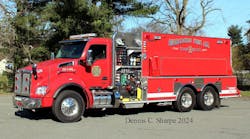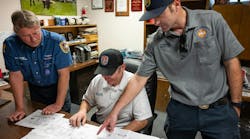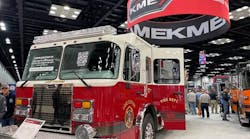Editor's Note: This article is part of a year-long series that explores the recommendations and philosophies of manufacturers and maintenance crews to help keep fire apparatus in good condition and available for the next response. The series starts on page 56 of the January 2010 edition of Firehouse Magazine and continues with the links below.
Every apparatus in service today is a compilation of various components. There's not a single apparatus builder in business today that makes engines and pumps or the thousands of other components that go in to an emergency vehicle.
Yet, each one of those separate manufacturers has its own specifications and maintenance recommendations. Most apparatus builders will compile those owner's manuals and maintenance schedules and present them on CD or in a binder, or some manner for the end user to know how to take care of their significant purchases.
Every apparatus built needs a cab and chassis, which includes all the running gear, some apparatus makers build their own cabs and chassis from the ground up while others buy them ready-made to apparatus specifications.
Spartan Chassis, a division of Spartan Motors based in Charlotte, Mich., builds hundreds of cabs and chassis specifically for the fire service. Their custom cabs and chassis are used in a variety of apparatus from pumpers and rescue vehicles, to aerials and even ambulances. Spartan Chassis is one of the largest makers of custom chassis in the nation.
Todd Chapman is Spartan Chassis' technical service supervisor and fully understands the importance of well maintained equipment.
"A fire truck has to go when the bell rings," Chapman said.
That's why Spartan has extensive training programs to teach EVTs, dealers, mechanics and even end users (the firefighters) about the maintenance of all components of a fire truck.
Chapman is a strong advocate of the importance of using trained and qualified people to work on trucks, particularly when it comes to brakes.
"If you are not an EVT, absolutely don't touch the brakes," Chapman said. "...They're often the most frequently overlooked part of an apparatus."
Chapman said firefighters and engineers should, however, check the free play of the brake slack adjusters, much like one would do for a pre-trip inspection by an operator with a commercial driver's license (CDL), by hand only. No one, except those expertly trained, should go near brakes with a wrench or a tool, he said.
And there are lots of other systems that really should be serviced by qualified technicians, like electrical systems, heating and cooling systems and suspension and steering systems to name a few.
Chapman said that there is no truck builder out there that builds its own components. They all use engines, transmission, axles and a host of other parts that make the whole apparatus. That's why it's important to follow the specific component manufacturer's maintenance recommendations.
He's also a big proponent of using the correct fluids and filters, even down to the brand name and models.
"You just can't go out and buy the El Cheapo brand filters, or fluids and expect the same performance," Chapman said. "They just won't do the job." He added that he likes synthetic oils and extended life coolants, all of which cost more, but last longer and, in the long run, pay huge dividends in reduced maintenance costs and prolonged apparatus life.
"You get what you pay for," Chapman said.
Bill Foster, vice president and member of the board of directors of Spartan Motors, has been the point man for the annual Spartan Chassis Fire Truck Training Conference for each of the 16 years the company has sponsored the event held in August. It offers training on pumps, compressed air foam systems (CAFS), steering, engines, transmission, electrical systems, tires and suspension with support from many of the component builders.
Foster, who is a co-founder of Spartan Motors and a firefighter for more than 30 years, is an advocate of training right down to the micro level.
"You can't fix a problem unless you know its root cause," he said. "If you've got a problem, you've got to diagnose it to fix it." Too many technicians are just "parts changers" these days, Foster said. To fix a problem the good technician needs to know why that component failed in the first place. It could be something as simple as a poor battery ground, but until that problem is fixed, changing the part isn't the solution, he said.
"People like to have good working trucks," Foster said.
The trend today is to make more things "maintenance free," but Foster cautions it doesn't exempt mechanics from checking the trucks over.
"Even those systems need to be monitored," he said. "They can sometimes fail or need to be serviced."
Next to the cab, chassis and engine, the heart of most fire apparatus is its pump and they also have their own maintenance needs.
For W.S. Darley & Co., with facilities in Itasca, Ill., and Chippewa Falls, Wis., pumps have been a staple of the company for more than a century. Each year, the company hosts training sessions at the factory and at various events around the country.
Lairy Normand is a sales application engineer for Darley and an instructor for the company. He is a proponent of annual pump testing and regular maintenance.
Normand said that, like an engine, pumps need regular oil changes at 50 hours of operation, or every six months whichever comes first.
Keeping the oil level full is also important, he said.
"The big midship pumps have dip sticks on them now making it easy to check the oil," Normand said.
And, pumps equipped with CAF systems have air filters needing service too, he said.
Darley makes filter kits for their pumps and Normand does not recommend straying from the manufacturer's requirement. There are times when filters will look exactly like factory, but they perform differently and can, sometimes, adversely affect operations.
"It's not a good idea to outsource filters," Normand said.
Pumps are equipped with electronic controls, pressure relief valves as well as pump seals and valves, all of which must be working in concert and at peak to get the most out of the pump's performance, Normand said.
Valves that stick can be remedied by spraying silicon lubricant into the ball area of the valve and working the lubrication into the mechanism by opening and closing it.
Leaky valves will mean the apparatus will have difficulty drafting, Normand said, noting that valves need maintenance and occasional rebuilding.
A way to check leaky valves is to take a latex, or similar, glove and place it over the valve outlet or intake. If the glove gets sucked in, it's likely the valve is leaking, Normand said.
Normand said pumps should not make any abnormal noises while operating and if they do, it can mean serious damage has happened to the pump, or is about to. If that happens, the pump should be shut down as soon as it's safe to do so and its source located.
Often, pumps simply need to be used to be properly maintained. Atrophy can cause things to stick and not work properly when needed most. Normand recommends cycling pumps in and out of gear a few times just to make sure all the components move as required. The advice is particularly useful to departments with low run numbers where the truck sits more than run.
Trucks that have multi-stage pumps should be cycled through all stages to make sure they engage properly on demand and not be stuck high pressure or high volume mode when the opposite is needed, he said.
Driveshafts that turn pumps also require maintenance and packing nuts need adjusting occasionally too, and there are foam systems that require care to work properly, Normand said.
Some apparatus are equipped with equipped with anodes, sometimes called Tank Savers, which are sacrificial metal, often magnesium that help reduce the corrosive properties of water in metal tanks. Anodes that are not changed when necessary can break and the fragments can be sucked into the pumps with the tank water potentially causing damage. Normand said they need to be checked periodically and replaced when necessary as part of a preventative maintenance program. Not all apparatus have Tank Saver anodes, particularly ones with poly, plastic and fiberglass tanks.
The Darley company is so committed to apparatus and pump maintenance, it hosts periodic pump schools at its Chippewa Falls plant covering from the basics of pump theory to ahnds on repair, service testing and troubleshooting.
"A truck well cared for in the fire hall will perform well on the scene," Normand said.





